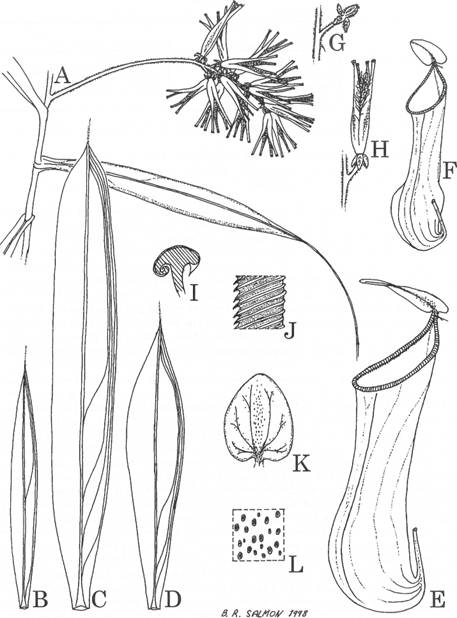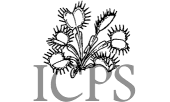|
Carnivorous Plant Newsletter
Volume 28, Number 1, March 1999, pages 14-18
NOTES ON NEPENTHES FROM NORTHERN SUMATRA
BRUCE SALMON • Auckland • New Zealand
RICKY MAULDER • Auckland • New Zealand
Received: 13 May 1998, revised: 28 July, 1998
Keywords: new taxa: Nepenthes angasanensis.
Summary
A previously unrecognized species of Nepenthes (Nepenthaceae) from Puncak Angasan, Aceh Province, Sumatra, Indonesia is described and illustrated. The original description of N. mikei is reinstated.
Introduction
On a recent field trip to Sumatra (Sept. 1997) a party of four people, three from New Zealand (Ricky Maulder, Bruce Salmon, Brian Quinn) and one from Australia (Dale Schubert), rediscovered a species that we regarded to require a formal description. We took guides from the town of Blangkejeren and on to Penosan where we began the climb at about 1600m. This species first appeared on Puncak Angasan (en-route G. Leuser) at 2400m and continued on up to 2600m where a recent fire had destroyed the higher forest. It is named by Dale Schubert.
General
At first glance this species bears a striking resemblance to N. tobaica. However upon further examination it became apparent to us that this species is not N. tobaica and that it required its own specific name. Several clues initially attracted our attention, leading us to believe that we were dealing with something new (see Table 1). At first glance this species appears similar to N. tobaica. However, combined with the above geographical and ecological observations, and the main morphological differences noted in Table 2, we believe that we are justified in the naming of a new species. Van Steenis1 collections from the same area (Puncak Angasan, G. Kemiri, G. Lembuh) that were placed into N. tobaica by Danser (1940) are also likely to be this species. This new species also has a slight resemblance to N. mikei but mainly in rosette leaf shape/attachment and inflorescence structure. N. mikei is not a very variable species, at least between specimens from G. Pangulubau2 and G. Bandahara. Even new herbarium material, recently collected from the type location, falls within the margins of the original description. (The original description was based on cultivated specimens.) We have not observed the characteristics in this species which are used by Jebb & Cheek s (1997) in their emended description of N. mikei. For this reason, we believe that Jebb & Cheek included other species in constructing their emended description. We feel that the orginal description should be reinstated until further studies can be performed.
--------------
1As we have not viewed the van Steenis nor the "Jebb & Cheek" herbarium material we are unable to confirm our suspicions at this time.
2Jebb & Cheek state that G. Pangulubau is in Riau Province when in fact it is in the Province of North Sumatra.
--------------
Table 1.
N. tobaica N. angasanensis |
Location |
North Sumatra, principally
the Lake Toba area. |
Aceh, possibly known from
only three mountains. |
Attitudinal range |
800-1500m. |
2300-2800m. |
Habitat |
Growing in clay and
volcanic soils in open scrub
- Leptospermum sp. |
Growing in moss and leaf
litter in mossy forest. |
The new species from Puncuk Angasan is formally described in the following text.
Nepenthes angasanensis Maulder R., Schubert D., Salmon B., Quinn B., spec. nov.
N. tobaica Danser similis sed ascidia radicalia longiora 120-150mm longa, calcar bis vel ter ramosum (non fasciculatum). Inflorescentia feminea, pedicellis unifloris, brevibus 55-125mm longa.
Holotypus: B. Salmon and R. Maulder (234372), Young plant with pitchers, leaf and pitcher from short shoot, female inflorescence, fruits. Sumatra, Aceh Province, G. Puncak Angasan, Slopes above Penosan, 2500m alt. 25 Sept. 1997 (AK).
Stems; climbing up to 9m high, cylindrical, 2-4mm broad. Scattered short shoots arise from underground rhizomes. Internodes, 20-60mm long. Leaves of the rosettes; coriaceous, sessile, linear, 50-70mm long, 10-13mm broad, acute at the apex, tapering gradually towards and abruptly contracted at the base, clasping the stem for 2/3 the diameter. Pennate veins; irregularly reticulate running obliquely to the margin. Longitudinal veins; 2-3 on each side running in the outer 1/3 of the blade, most originating from the midrib near the base and sometimes from up to 1/2 way along the blade, converging at the tip. Tendrils; slender, 1-1.5mm broad approximately 2/3 to the same length as the leaf, descending without curl. Leaves of the short shoots; similar to those of the rosette but larger, 100-200mm long, 12-25mm broad with 3-4 longitudinal veins running the length of the blade. Leaves of the climbing stem; similar to those of the rosette and short shoots, perpendicularly attached to the stem, lanceolate, obtuse/acuminate at the tip, 100-120mm long, 20-25mm broad. Tendrils; bearing pitchers with a single or double curl. Pitchers of the rosettes; abruptly incurved at the front from the hanging end of the tendril. Pitchers facing the centre of the rosette, 60-80mm long, 18-20mm broad. Narrowest from the front, ovate in the lower 112, ventricose in the middle, tubular to slightly infundibuliform in the upper 112, narrowing slightly towards the mouth with two fringed wings running the entire length. Wings; 1-1.5mm broad, fringe segments filiform, 3-6mm long and 8-12 fringe segments cm- 2. Mouth; oblique, elevated towards the lid. Shape ovate becoming acuminate towards the lid with almost no neck. Peristome; rounded, 1-1.5mm broad in front, 3-4mm broad near the lid. Ribs; 0.4-0.5mm apart, 1.5-2mm long on the inner margin. Inner surface of the pitcher; glandular in the lower 112 with minute overarched glands. Glands; evenly distributed, rotund, 0.2-0.3mm long and 300 cm- 2. Glands becoming larger towards the bottom with upper 1/2 glandless and pruinose. Pitcher lid; ovate, cordate at the bottom, rounded at the top. The lower surface glandular with a few scattered minute rotund and rimmed glands, the long axis of the glands being oriented parallel with the long axis of the lid, midrib almost nonexistant. Spur; forked, 0.3-0.4mm long inserted at the base of the lid. Pitchers of the short shoots; similar to those of the rosette but larger, abruptly incurved at the side from the hanging end of the tendril, facing outwards from the stem, 120-150mm long, 30-40mm broad. Lid; 30-35mm long, 25-28mm broad, glands; few, concentrated along the midrib and scattered around the edge, 0.2mm long. Wings reduced to ribs. Spur; singular, sometimes branched, 6-7mm long. Pitchers of the climbing stem; similar to those of the rosette but often very bulbous in the lower 1/3, abruptly incurved at the back from the hanging end of the tendril, 80-90mm long, 18-25mm broad. Lid; 18-22mm long, 15-20mm broad. Lid glands; 0.1mm long, sparse, concentrated at the midrib and scattered over the surface. Wings; reduced to ribs. Spur; single or branched, 3-4mm long. Male inflorescence unknown. Female inflorescence; a raceme. Peduncle; cylindrical, 40-90mm long, 1.2-2mm broad. Axis; gradually tapering towards the tip, 15-35mm long bearing 9-17 flowers. Pedicels; situated in a whorl, 1-flowered sometimes with a 1-1.5mm long bracteole near the base of the lowest flower, 5-20mm long; interpedicel length 2-9mm; pedicel bases, 0.5-1mm broad, 3mm long near the top of the axis, 9mm long near the bottom. Tepals; lanceolate, cupped, 4-5mm long, 1.5mm broad, reflexed; inner surface glandular, glands, elliptic, rimmed, 0.1-0.2mm long, the long axis of the glands being orientated parallel with the long axis of the tepal. Carpels; 5-7mm long, 2-3mm broad being shortest near the top of the axis. Fruit valves; 20-27mm long, 3-4mm broad. Indumentum; very sparse on mature parts, the stems and leaves, including their axils, glabrous. Tendrils covered with filiform hairs, 0.2-0.5mm long. Pitchers and lid sparsely covered with filiform hairs, 0.3-0.5mm long. Peduncle, pedicels and ovary densely covered with short filiform adpressed hairs, 0.3mm long. Outer surface of tepals also with a few of these hairs. Edges of tepals densely tomentose, hairs filiform, curled, 0.05-0.1mm long.

Figure 1: N. angasanensis: A) stem with female inflorescence x 1, B) Lower leaf (rosette) x 1, C) Intermediate leaf (short shoots) x 1, D) Upper leaf (climbing stems) x 1, E) Intermediate pitcher x 1, F) Upper pitcher x 1, G) Female flower x 1.5, H) Ripe fruit x 1.5, I) Peristome cross-section x 10, J) Detail of peristome viewed from above x 10, K) Lid (underside) x 1, L) Detail of glands on underside of lid x 10.
Table 2: Comparisons between N. angasanensis and its nearest relatives, N. tobaica and N. mikei
N. tobaica N. angasanensis N. mikei
Habit |
No rhizomes. |
Produces offshoots
from underground
rhizomes. |
No rhizomes. |
Spur |
Filiform. |
Forked. |
Fasciculate. |
Inner margin
of Peristome |
Teeth < 0.2mm. |
Teeth to 1.5-2mm
long. |
Teeth to 0.2-0.4mm
long. |
Stem cross
section |
Cylindrical to
obtusely triangular. |
Cylindrical. |
Cylindrical. |
Bracteoles |
At base or slightly
below pedicel
attachment. Few |
Sometimes near
base of lowest
pedicel only. |
Half way up every
pedicel. |
Pitcher glands |
200-250 / cm2. |
300 / cm2. |
150-180 / cm2. |
Pedicels |
2-flowered. |
1-flowered. |
1-flowered. |
Inflorescence
(female) |
195-400mm long,
30-50 flowers. |
55-125mm long,
9-17 flowers. |
40-80mm long,
4-10 flowers. |
Colour
Herbarium specimens; Brown to blackish. Living specimens; Stems; dark red to black. Leaves; glossy green above lighter below. Midrib; light green. Tendrils; green, turning pitcher colour towards the tips. Pitchers; red to black sometimes green or flecked with red outside, whitish green or reddish inside. Lid; like that of the pitcher. Peristome; green, sometimes red or black. Inflorescence; dark green/grey. Indumentum; white, tepal edge hairs brown.
Distribution
Indonesia, Aceh province, Puncuk Angasan, slopes above Penosan, 2400-2600m.
Ecology
Open, montane, mossy forest among trees reaching 12m high. Forming a few hybrids with N densiflora where their ranges overlap.
Derivation
The specific epithet angasanensis refers to the mountain from which the type specimen originates.
Specimens Examined
N angasanensis: B. Salmon & R. Maulder, 234372 (Holotype), Young plant with pitchers, leaf and pitcher from short shoot, female inflorescence, fruits. Sumatra, Aceh Province, G. Puncak Angasan, Slopes above Penosan, 2500m alt. 25 Sept. 1997 (AK). Duplicates sent to (K), (BO).
Acknowledgements
We would like to thank the staff of the Auckland Institute and Museum Herbarium for their help with the preparation of specimens. Also thanks to Jan Schlauer and Charles Clarke for their helpful critique of our manuscript.
Literature
Danser, B. H. 1928, The Nepenthaceae of the Netherlands Indies, Bull. Jard. Bot. Buitenzorg, Serie III. Vol. 9, pp. 382-384.
Danser, B. H. 1940, A New Nepenthes from Sumatra, Bull. Jard. Bot. Buitenzorg, Serie III. Vol. 16, pp. 268-271.
Salmon, B. and Maulder, R. 1995, Two New Species of Nepenthes from North Sumatra, Indonesia. Carniv. Pl. Newslett. Vol. 24, pp. 78-84.
Jebb, M. and Cheek, M. 1997, A Skeletal Revision of Nepenthes (Nepenthaceae), Blumea Vol. 42, pp. 63, 86-87.
|

